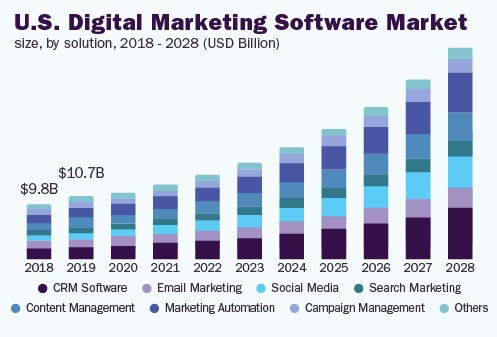Digital marketing requires analytical tools
Article Summary
This is a research-based article that would take approximately 3 to 4 minutes to read and it covers the latest trends in the contemporary digital marketing industry. These trends include programming advertising, AI-powered chatbots, conversational marketing with consumers, and other technologies.
Overview
Defining the concept of “digital marketing” will be beneficial prior to the analysis of related trends. Digital marketing has been simply defined by Kasperovich (2021) as the use of multiple channels or forms of digital channels in order to promote a brand, company, product, or service. The following aspects are data-related technologies as well as other concepts that are closely related to almost all digital marketing trends:
• Big data (e.g. data stored in data warehouses of supermarkets)
• Data science and data analysis (e.g. visualising data metrics of product popularity)
• Artificial intelligence and machine learning (e.g. of consumer online purchasing patterns)
• Social media (e.g. targeting customers using social media platforms)
Growth, Significance and Value Contribution by the Digital Marketing Industry
The significance of digital marketing and the value generated within the sector as propounded the rise of a number of various technologies, including the above. For instance, the CAGR or the compound annual growth rate of the global digital marketing sector is forecasted to be at 18.2% from 2021 to 2028 (GV Research Inc., 2021). According to journal papers, the shift from the traditional mass marketing to a more consumer-oriented marketing has led to the rise of digital marketing and associated trends (Milchakova and Reshetnikov, 2020).
The chart presented subsequently displays the digital marketing industry (as far as the software sector is concerned) forecast in the U.S. and it is classified in to multiple digital marketing segments. As clearly evident, the growth rate will take on an exponential increase in the foreseeable future.

Figure 1 - Forecasted growth in digital marketing software
(Source: GV Research Inc., 2021)
Programmatic Advertising
This is one of the latest concepts of digital marketing and programmatic advertising can be defined as "the algorithmic purchase as well as sale of digital or other advertising space in real-time."
This typically refers to that instead of humans, a custom or programmed software or AI solution identifies, purchases, places, and matches available digital advertising spaces with compatible advertisers (e.g. client corporations) via a bidding system (Pottinger, 2018).
This allows placing adverts on popular websites, digital billboards, online e-magazines, social media pages, and other platforms and most of the involved processes are carried out by software with minimal human supervision. A benefit of adopting this approach is the creation of large volume of targeting options as well as combinations to advertisers and the reduction of human effort and time.
Despite the advantageous scenarios of these techniques, no marketing or programmatic algorithm will be able to affectively be useful and insightful to all advertisers in a partial manner (Stevens, Rau, and McIntyre, 2016).
A specific statement by a journal paper is of extreme value to comprehend this particular trend. If interactive advertising is considered to be the first phase of digital advertising, then programmatic advertising along with AI or intelligent advertising will be the second and third phases of digital marketing and digital advertising. (Li, 2019)
Conversational Marketing
As explained by the recent research of Domegan (2021), the recent focus of marketers is more on social marketing as well as behavioral changes of online customers. As a result, a more customer-friendly and step-by-step strategy is a viable. This is where the novel conversational marketing trend is valuable. The underlying principles of this particular technique is the “personalisation of the customer or user experience” through data collection, analysing and identifying the needs and preferences of the customer (Stepanov et al., 2021). This leads to a more efficient marketing end-result.
Similarly, other researches, including that of Edlund and Härgestam (2020), state that conversational marketing is a concept similar to “social customer relationship management” (sCRM). Essentially, this technique relies heavily on chat bots.
AI-powered Chatbots
Artificial intelligence now plays an increasingly critical role in multiple technologies and AI-chatbots are now a common technique in marketing. These chatbots are more than typical enquiry agents. They are able to assist employees with a wide array of tasks that take place along a customer's journey (Chong et al., 2021).
However, there are critical opinions on the success of these chatbots. One popular viewpoint is that these replace actual human connections and even if chatbots are given a natural tone, technology is unable to be empathetic and sound like human (Verma, Chandra, and Joshi, 2021).
Conclusion
Overall, this article looked at a research-driven assessment of digital marketing and associated trends. It was evident that there will a significant growth in this field but while there are beneficial outcomes to marketing firms and advertisers, there could be adverse impacts to the end-user or the consumer. It should also be highlighted that this article touched upon just a few selected trends but there are other various trends in the digital marketing and advertising space. These include in-email purchasing where the customer does not have to visit external links but can purchase products from their email inbox, virtual reality and augmented reality customer journeys, and social media influencer marketing plus affiliate discounting mechanisms.
Author:
Kusal Sameera
Disclaimer: This content is for the sole purpose of teaching and learning at Edith Cowan University.
22 Sept 2021
------------------------------------------------------------------------------------------------------------






Comments